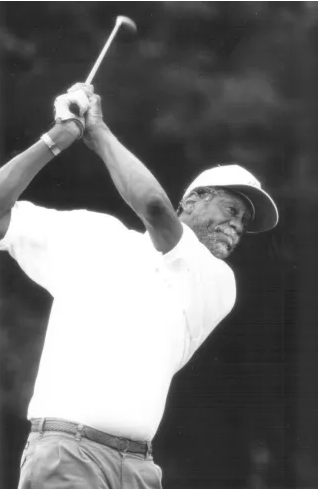(Originally published in the Sacramento Observer)
It was no coincidence that local golf enthusiast Willie Simmons Jr. and his childhood friend and National Basketball Association legend Bill Russell would end up living in Oakland in the 1940s.
Simmons’ and Russell’s families relocated from West Monroe, Louisiana, to the West Coast to escape segregation laws, disenfranchisement and racial violence. Simmons was 12 while Russell, who recently passed away, was about four years younger than the man who would be his friend for life.
“We were actually sons of the Great Migration,” Simmons, 92, told The OBSERVER. “I know it hasn’t been talked about but we were a part of a movement coming from the Deep South, the southwestern part of the country. Yes, I’ve known Bill all of his life. It’s a story to be told.”
Russell, a civil rights icon who won 11 NBA championships with the Boston Celtics, died at age 88 on July 31. He was also a past head coach of the Sacramento Kings and briefly served as the team’s vice president of operations.
Simmons founded the nonprofit Northern California Minority Junior Golf Scholarship Association in 1990. The organization promotes education, youth/adult golf training programs and provides collegiate scholarships and financial aid to deserving students.

“When Bill was living here he’d call me just about every day. He took me to some of the most exclusive golf courses around Sacramento. He lived in a golf community in nearby Rancho Murieta (25 miles southeast of Sacramento),” Simmons said. “But our relationship goes further back to West Monroe. We were born a block and a half from each other. Our families went to the same church and we went to the same school.”
Around June 1943, Simmons said, both families left the Deep South for better opportunities in Oakland. The Great Migration was a large exodus of more than 6 million African Americans from the rural South to the cities of the North, West, and Midwest from about 1916 to 1970.
The West Monroe families were a part of the second migration wave, which started around World War II. The Russells first drifted to Detroit before landing in Oakland, Simmons said.
“Mr. Hawk (a term Black people use to refer to cold weather) rushed through there and got to Mr. Russell,” Simmons said. “They couldn’t handle that freezing weather. Ms. Russell had asked where did my father (Willie Simmons Sr.) go. They told her he went to Oakland. So, the Russell family ended up in Oakland. My family was responsible for about five West Monroe families’ move to California.”
When Russell’s mother Katie Russell passed away in 1946, his father William took her back to West Monroe for burial. Simmons’ mother was there visiting family. When it was time to return to Oakland, William Russell sent his son back to Oakland with Simmons’ mother. The father stayed behind to take care of other affairs. Bill Russell had to return to school.
“Bill laid in my mother’s lap on a five-day train ride back to California,” Simmons said.
Simmons graduated from Oakland’s McClymonds High School in 1948 and Russell in 1952. Simmons eventually would move to Sacramento after graduation. His family had moved to Sacramento in 1947, but he stayed in Oakland with family friends to finish high school.
Russell became a basketball star for the University of San Francisco, winning back-to-back national titles. The St. Louis Hawks traded him to the Boston Celtics moments after he was drafted into the NBA in the mid-1950s.
Simmons said Russell was nearly a Celtics teammate of Donald Barksdale, the first Black player chosen to play in the NBA All-Star Game and the first Black athlete to make the Olympic basketball team in 1948. Barksdale, born in Oakland and a product of UCLA, was Simmons’ favorite player.
Barksdale was a Celtic from 1953 to 1955. He was a ferocious rebounder and defender but ankle injuries curtailed his brief career. Simmons said Barksdale’s departure was “probably”one of “two reasons” why Russell was tabbed to play in Boston.
“I was a Barksdale fan but later I used to go watch Bill and the Celtics play when the San Francisco Warriors played at the Cow Palace in San Francisco, and then at the Oakland Arena when the Warriors started playing there in (the mid-1960s),” Simmons said. “But the significant thing about his career was the fact that the St. Louis Hawks didn’t want any Black players. They had the second pick in the 1956 draft. Red Auerbach, the Celtics’ coach, really wanted Bill because he could rebound and play defense. And the rest is history,” Simmons said.
Long after his playing days and stints as a head coach for the Celtics and Seattle Supersonics, Russell would unite with Simmons in Sacramento in the late 1980s. After he was hired to coach in Sacramento, the Hall of Famer found out Simmons was a season-ticket holder of the Kings.
Every Sunday, Simmons would put together “standard tee times at golf courses,” he said, with a group of 10 or 12 players at Dry Creek Ranch Golf Course. The activity was one of many Simmons and Russell would engage in around the Sacramento region.
“Every day the phone rang my wife would say, ‘Your friend is calling again,’” Simmons said. “He’d call me to say what golf course to meet him at. It was actually during the days when he was the general manager of the Kings he’d call often. The only golf course he didn’t take me to was the Del Paso Country Club. But the rest of them, you name it, we played there.”
After Russell was released as the Kings’ vice president of basketball operations in December 1989, he and Simmons still would meet up at golfing events on the West Coast. Simmons said Russell frequently would mention his name in conversation when he was an NBA television commentator.
On Aug. 11, the NBA and National Basketball Players Association (NBPA) announced that Russell’s No. 6 jersey will be retired league-wide. The iconic NBA champion and civil rights pioneer will be the first player to have his number retired across the NBA.
“Bill Russell’s unparalleled success on the court and pioneering civil rights activism deserve to be honored in a unique and historic way,” NBA Commissioner Adam Silver said. “Permanently retiring his No. 6 across every NBA team ensures that Bill’s transcendent career will always be recognized.”
NBPA Executive Director Tamika Tremaglio said retiring No. 6 “is a momentous honor reserved for one of the greatest champions to ever play the game.”
“Bill’s actions on and off the court throughout the course of his life helped to shape generations of players for the better and for that, we are forever grateful,” Tremaglio said. “We are proud to continue the celebration of his life and legacy alongside the league.”
Simmons honoring Russell is truly a testament to the millions of Black people who participated in the Great Migrations, “seeking better opportunities, better conditions and better way of life,” he said.
Simmons retired after 36 years as a general superintendent for the Department of Defense, “a job that took me all over the world,” he said. Nonetheless, what Bill Russell went through in his life on and off the basketball court basically defined the mass movement out of the Deep South.
“He turned the game around. Bill brought defense to the game of basketball,” Simmons said. “When he passed, someone suggested that they do the same thing for him (retire his jersey) as they did for Jackie Robinson. So, none of this probably would have happened if our families had not left West Monroe during the migration.”


